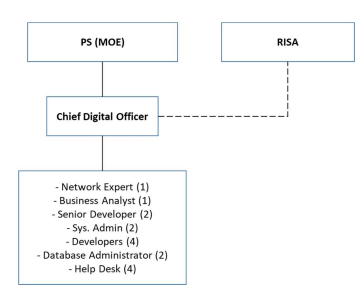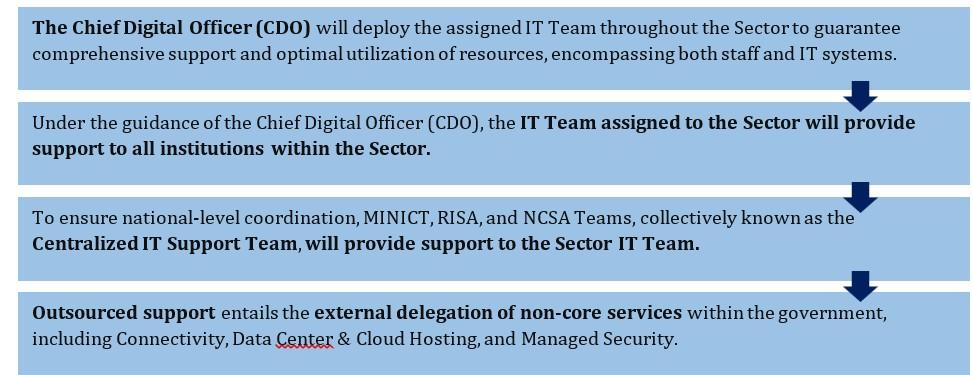Positions and Reporting Mechanisms under the shared services
The clustering approach revolves around establishing a unified IT Team, headed by a Chief Digital Officer (CDO) or an IT Business Analyst. This team is responsible for offering IT leadership, support, and the development of IT systems for all institutions within the Sector. The remaining members of the IT Team are distributed under the lead Ministry and within each of the sector's institutions. Additionally, the CDO maintains a direct reporting line to RISA, serving as the supervising authority.
Figure 8: Example of an organisation structure of sector IT: case of the Ministry of Environment
Area 1: IT Infrastructure Management:
- Centralised management of IT infrastructure, including servers, networks, and data centres.
- Maintenance and updates of hardware and software across all affiliated agencies.
Area 2: Network Services:
Area 3: Cybersecurity Services:
- Centralised cybersecurity measures, including firewalls, intrusion detection systems, and antivirus solutions.
- Monitoring and response to cybersecurity threats across all affiliated agencies.
Area 4: Data Management and Analytics:
- Centralised data storage and management services.
- Analytics services for extracting insights from data shared across different agencies.
Area 5: Software Development and Support:
Area 6: Help Desk and User Support:
- Centralised help desk services for providing technical support to users across affiliated agencies.
- Standardised procedures for issue resolution and user assistance.
Area 7: ICT Procurement:
- Centralised procurement of ICT hardware and software to leverage bulk purchasing and negotiate better deals.
- Standardisation of ICT procurement processes.
Area 8: Training and Development:
Area 9: Cloud Services:
- Utilisation of cloud services for shared storage, computing power, and applications.
- Collaboration on cloud-based solutions to enhance efficiency and reduce costs.
Area 10: Collaborative Platforms:
- Implementation of collaborative platforms for communication and project management.
- Shared tools for document sharing, collaboration, and workflow automation.
Area 11: ICT Governance and Policy:
- Development and enforcement of standardised ICT governance and policy frameworks.
- Oversight and compliance monitoring across all affiliated agencies.



No Comments